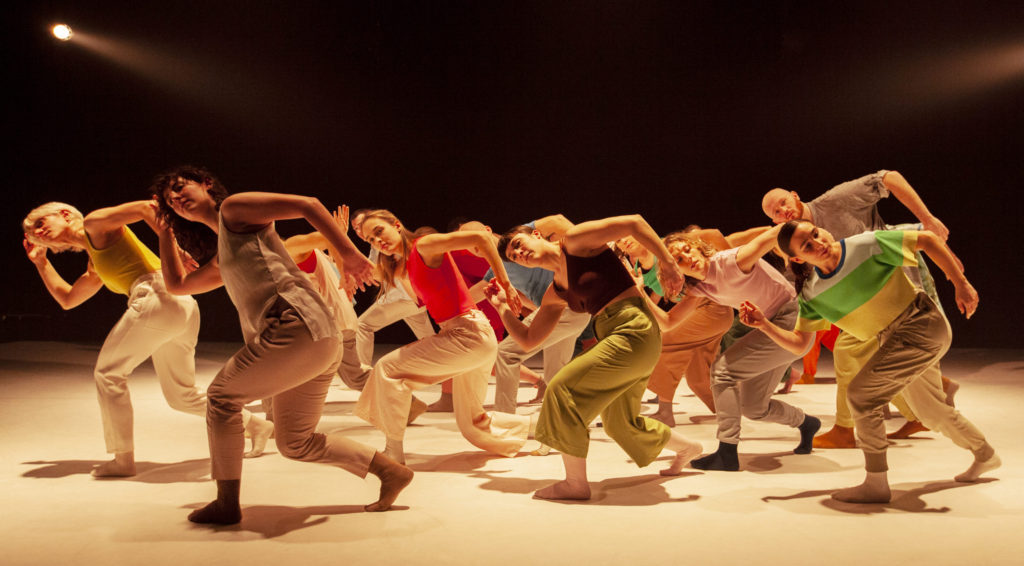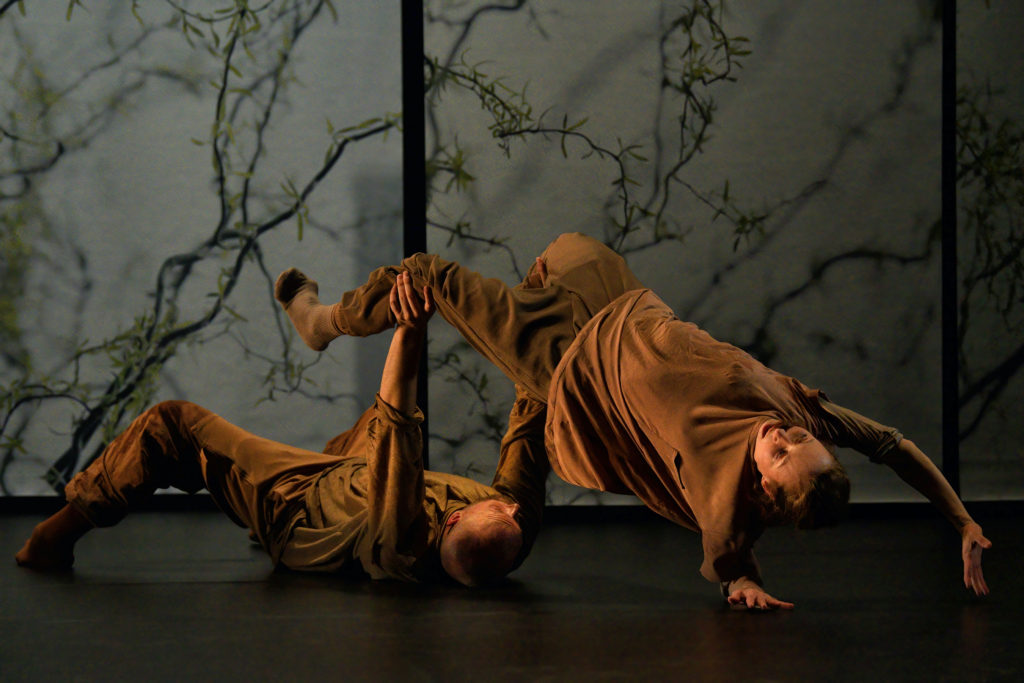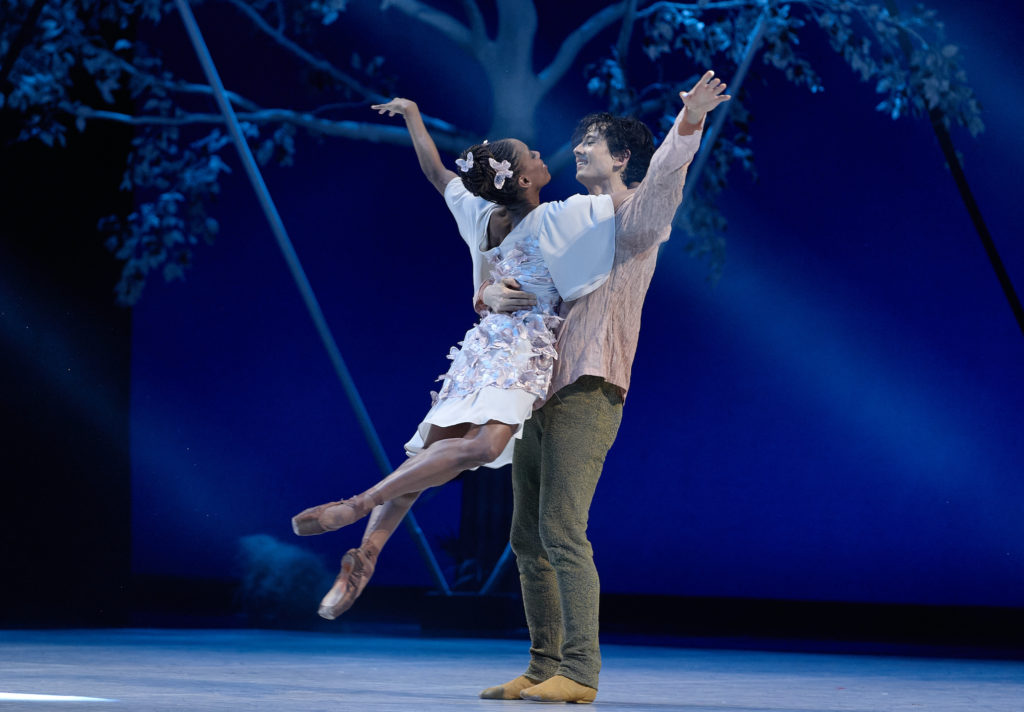Montreal nights of musicals, moderns, circus, ballet - Vancouver Ballet Society
- Home
- City Reports 2020 - 2023
- Montreal nights of musicals, moderns, circus, ballet

By Victor Swoboda
In March, midway through Broadway Across Canada’s run of the musical Cats at Place des Arts, Montreal theatres dropped COVID passport requirements. Cats was Montreal’s first Broadway musical in over two years, and the public filled the city’s biggest hall to the uppermost tiers. Andy Blankenbuehler’s adaptation of Gillian Lynne’s original choreography had more virtuoso pirouettes and jumps than the Broadway staging I saw 30 years ago. The chorus of 20 cats wove movement patterns as intricate as the warp and weft of an oriental rug.
My enjoyment of Blankenbuehler’s choreography brought to mind Rhapsodie, the new hour-long work for 20 dancers by veteran Montreal choreographer Sylvain Émard, which I saw a month earlier at the Wilder Building’s Studio Theatre. Having staged outdoor performances of Le Grand Continental with upwards of 3,000 amateur line-dancers, Émard knows something about group movement.

Presented in the round by the Danse Danse series, Rhapsodie began with one dancer initiating an upper-body gesture that was picked up in turn by the others, like a musical canon. Another dancer then initiated a different gesture that the others repeated. Eventually dancers moved about the space in strict patterns. Groups formed. Occasionally the groups separated and inhabited a different space, maintaining cohesion through common gestures. Observing the variety of gestures and the smooth flow of movement, I felt delight akin to listening to light Baroque music. Regrettably, there was no tension or drama except for a moment when the dancers uncharacteristically hugged. As pretty and clever as Rhapsodie was, the single-toned choreography made its point long before the hour’s end.
Urban dance has served as a rich lodestone for contemporary Montreal choreographers, including Anne Plamondon. Her thoughtful hour-long duet with James Gregg, Seulement toi (Only you), richly exploited urban dance’s angularity and stop-start rhythm to show an adult relationship in progress. Seulement toi opened and closed with a sequence out of everyday life in which the two tried on different shirts behind a scrim. During subsequent partnering, their limbs conjoined into pretzel-like positions, locking and unlocking without strain. Such compelling interaction seemed at odds with their too-bland bits of spoken dialogue. But both dancers shone in solos revealing their individuality. Knowing how to embrace and when to let go was the key, the choreography suggested, to overcoming solitude.

At the start of Se dissoudre, a solo by another contemporary local choreographer, Catherine Gaudet, dancer Marie-Philippe Santerre stood still while relentlessly making pelvic thrusts that surged to her upper body with such force I feared for her physical wellbeing. Eventually she edged to the floor as the music quietly throbbed. Later came vigorous arm thrusts with pauses in freeze position. Earnest to a fault, the piece became increasingly grimmer. At the end, facing the audience, Santerre jiggled her hips and shoulders ever faster as though gripped by outside forces. Falling artificial snow covered her as the Agora de la Danse stage went black. Whether this was meant to be uplifting was hard to tell in a piece that left me cold.
Over the past 15 years, Montreal dancer/choreographer Andrew Turner has created several works that mix movement, video, and philosophical dialogue. In his solo show at La Chapelle, 18 Practices, he often relied on his onstage computer console. After showing some light-sabre enthusiasts performing on YouTube, Turner himself twirled two light sabres prettily in the dark. He also recorded himself speaking backwards, then reversed the recording so that he could enter into an odd-sounding dialogue with his own image on the computer screen. Donning a Trojan helmet, he walked and tumbled in a short dance. In Homer’s Odyssey, Turner told us, the timeframe zigged and zagged so readers could themselves feel something of Ulysses’ confusion. Like The Odyssey, 18 Practices rambled. Unlike The Odyssey, Turner’s trip was too comfortably entertaining to question where it was heading.
With seasoned performers like award-winning independent artist Angelica Bongiovonni, circus approaches high art. On the Cyr wheel, her changes of speed and body positions created such an intimate connection to the wheel that her number at Le Monastère might well be considered a duet. Even her fingers gesticulated expressively. In a comparably dramatic solo in Cirque Eloise’s new cabaret show, Celeste, at the Queen Elizabeth Hotel until July, Jimmy Gonzalez twisted and turned while juggling bits of soft clay so deftly that he seemed to master space.

Finally, to a major ballet offering, Les Grands Ballets Canadiens new Romeo and Juliet. In attempting to make an original neoclassical version set to Prokofiev’s familiar score, Les Grands’ artistic director Ivan Cavallari bizarrely lost sight of the “star-crossed lovers.” Referencing pre-Shakespearean Italian versions of the tale, Cavallari introduced sub-plots of love and jealousy involving secret liaisons between Lady Montague and Lord Capulet, and Lord Montague and a new character, Lady Guelfi. Romeo and Juliet’s ardour repeatedly disappeared from view, disrupting the narrative’s emotional buildup. Duets were not compelling, with dancers sometimes straining in awkward lifts.
The ballet’s design faltered, too. Costumes sported little wings and chest triangles like outfits from the Flash Gordon sci-fi serials of the 1930s. Dancers wearing shoulder harnesses pranced on prop horses that looked like oversized sheepdogs. Aristocrats pushed fluffy stuffed dogs on sticks as though polishing the floor.
Such ludicrous touches were somewhat offset by some effective innovations. Mercutio’s vulgar gestures — he once dropped his fly — appropriately conveyed his ribald nature. Fight scenes were impressively aggressive. Romeo introduced himself to Juliet at the first act ball by falling comically on his face. Opening night leads, Hamilton Nieh and Kiara DeNae Felder, finally found the requisite passionate heat in the last scene in which their bodies and faces expressed a mature calm as they confronted death. Overall, however, this Romeo and Juliet was a tepid affair.

